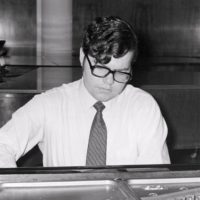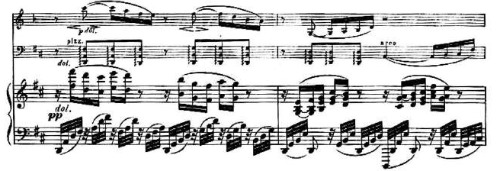My introduction of Emanuel Ax in May in Boston, as he received an honorary doctorate from New England Conservatory. "For a long time the listeners of the world have admired -- for a long time, the listeners in the world have loved Emanuel Ax. Hearing him play Century Rolls, the piano concerto written in 1997 by John Adams for him, first played by Mr. Ax and the Cleveland Orchestra, I was thrilled. As I was thrilled hearing him play Brahms’ … [Read more...]
Rising Tide
Patterns of rising and falling inflection are vital to a lot of music. Purely instrumental music often encodes emphasis-patterns that resemble speech, or song. (Linguists prefer the term "intonation" to signify these rises and falls.) In the notation of European classical music, at least since the 18th century, musicians have used "slurs" as a means of indicating phrase groupings and stress patterns. Describing two notes written under a slur, … [Read more...]
Open String
Piano music may reference or be contextualized by music made on other instruments, or sung. Some piano music mimics other instruments. The mimicry might be subtle, or subliminal. In Brahms's Intermezzo, Opus 118, No. 1 -- revered by Milton Babbitt -- there's an extraordinary cadence: Brahms: Intermezzo, Opus 118, Number 1 In my ear/mind, the low open strings (C and G) of the cello are sounding. Musical norms or expectations encoded … [Read more...]
Sonic Enharmonic
Words can be bent in pronounciation to suggest other words -- subtly shading, or adding on to signification. In B.o.B.'s "So Good," the word groups "how you feel [fe-el]," "fantasy oh," "put your feet up," and "Señorita" are made almost to rhyme, and conform to the same four-syllable emphasis-pattern. The sound is the word is the music is the sound. It's joy-inducing virtuoso display. Wordless music also offers possibilities for sonic … [Read more...]
Unhinged
C. P. E. Bach writes in his treatise: "A musician cannot move others unless he too is moved. He must of necessity feel all of the affects that he hopes to arouse in his audience, for the revealing of his own humor will stimulate a like humor in the listener. In languishing, sad passages, the performer must languish and grow sad. Thus will the expression of the piece be more clearly perceived by the listeners...." It's an old and ongoing … [Read more...]





